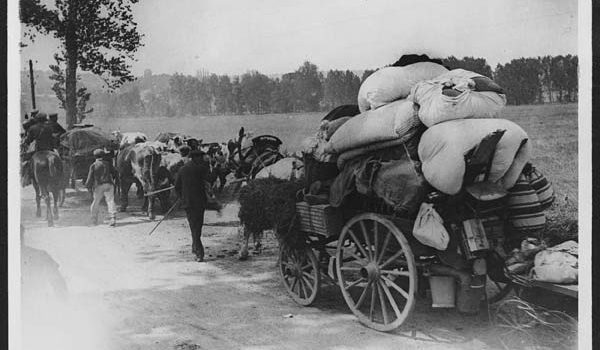Build the Plan vs. Test the Plan – Part 2
by T.R., Survival Blog:

(Continued From Part 1.)
During 2018, I made a dot chart counting how many days fit into each category A, B, C and D in terms of readiness and then converted the “dots” into a percentage of time for the year. As a corollary, if things are leaning environmentally towards TEOTWAWKI, then we would already be limiting our “D” types of trips away from home and/or starting to pursue our exit via our “B” plan scenario. If things look particularly grim but quasi-temporary, then we would limit our “C” scenarios to avoid leaving home for long blocks of time and leaning towards staying home at night altogether.
Regardless, our “A plan” (we are at home, with car stocked with a basic bug out bag in the trunk and miscellaneous winter gear for an emergency) represents our most outfitted and overstocked scenario, had already been tested multiple times from local power grid outages (Hurricane Sandy or Hurricane Irma or other ice storms) and been a major focus of our efforts over the last few years. Furthermore, we have a food rotation plan with a paper log book coupled with a large propane tank for stove top cooking, fireplace heat and a water supply. Whilst we can always make improvements, this “A” plan of “stay at home” is the strongest and most resilient of our four-pronged flowchart. We add gear, test new ideas and share them with our grown kids on camping trips each year and then back-feed those ideas into each plan. However, not all of the gear could fit into a vehicle for the “B” plan for Get-out-of-Dodge, not even close.
Around Easter/spring, we typically begin refrain from buying new groceries until we draw down some of our non-perishable food rotation to keep it fresh/cycle the stock and also because that eats down the pantry and fridge somewhat before we go on vacation to save a little money. I test a few new recipes for weekend gatherings, and we rate them for gourmet quality and ease of preparation. Since my husband does most of clean up while I do the bulk of provisioning and cooking, we added ease of clean up as a sorting criterion as well.
Before readers get ahead of themselves, we have historically put quite a bit of effort into shaping meals that are easy to prepare, easy to clean up afterwards, taste great and have a complement of fats/proteins/carbs depending our preferences at the time. I have been capturing these meal variations on a crib sheet on my computer and then printed in tiny font stuffed into the bottom of my dry storage can that houses our cook kit. Two years ago (because we switch houses with an off-the-grid cottage for a summer month, for example), I decided to create food trunks. Each location has a Walmart hard plastic trunk (which can double as a “bear canister” in camp and we can run a light cable through the lid lip to lock it as needed). The trunk has an assortment of canned goods, spices, staples like salt/pepper, coffee mate. I was tired of finding expired food in the pantry and wanted a more time effective solution for making meals and having some of those staples move with us when we left for vacation.
SNACKAGE
Another trunk contains mostly ready-to-eat snacks like Clif bars, ziplock bags of hard candy, containers of mixed nuts or dry roasted peanuts for fast energy, peanut butter (and a plastic knife), and triscuit crackers which seem to hold their freshness better and have more fiber and taste. After the last hurricane, I added Frosted Shredded wheat (taken out of the box but left in a sealed pouch) as a breakfast snack that is cost effective, and a few other items. Your trunk (or lock box) can be as small or large as you want; for us, at home we just leave the trunk with the lid open in the pantry hall and use it for snacking when we are going about our daily/weekly roles.
Looking at our “D” plan (away from home, no car coupled with very limited EDC bag and minimal equipment) was a revelation of how exposed that scenario presented risk for us and the weakness of same. To further sharpen this point, our “D” plan is logistically hard to improve upon (for example, when flying to visit friends or family for a long weekend, how much actual survival gear can we bring with us for that duration?).
My “dot chart” analysis shows that more than 60-70% of the time we are home (“A” plan) or have our car/truck (“B” plan). Logically, if the “B” plan conditions are harder vs. the “A” plan scenario (presumably involving less gear and lower comfort levels), but we can make the “B” plan functionally successful, then it will also be a solution for the “A” scenario. For us, it made more sense to test drive this leaner and more challenging scenario. As a reminder, in our “B” plan, for whatever reason, we are leaving our home in our truck or my husband’s woodworking project minivan, with only the gear that we can add/pack into the vehicle within a short trigger time (e.g. pack and go in 3-4 hours) with stock on hand whilst assuming that gas stations and local stores are already closed to test out the plan via realistic field conditions as a simulation).
If situational awareness enabled a longer lead time, and we hope that our monitoring of news and the like would help, then that much the better. However, our base case Get-out-of-Dodge test presumed a short trigger with “items on hand” and assumed some sense of urgency to leave due to the specifics of the situation. The “B” plan also rang true personally since we had recently evacuated from Hurricane Irma and had a few lessons learned from that. As hurricane preparedness, we had pre-planned to switch houses with long time family friends and vice versa. As it turned out, despite hundreds of miles between our respective locations, both of us evacuated North much earlier than required but with less wear and tear than most.
READY TO GET REAL?
Yet we asked ourselves…are we ready for a real problem and extended power outage and challenging situation well beyond our experience of an ice storm in Washington DC (losing power for 8 days) or Hurricane Irma aftermath which created some wobbles for about 10-12 days? We loved reading Patriots for the 3rd time and 4th time, but how would we really do in the fictional Todd Gray’s situation or similar challenge? To amp things up, we wanted to see how we would do for 30-45 days in a row (that was the time bracket we had to be off the grid away from my job entirely) and fully test out scenario B – away from home but with our car, limited gas constraints, remote mountain location, reasonably cold weather (hovering around freezing or below for half of the nights and milder weather by day), no power and finally zero ability to augment/supplement our gear buying at a store and therefore living off the food we brought with us. Finding a place worth visiting with wildlife or hunting or nature or some combination might make our field test more fun along the way as well, obviously, so we picked Rocky Mountain National Park and Yellowstone.
As engineers, we looked at the array of learnings from our readings and a few observations from camping trips in the past – and realized that we can’t “test” everything at once. Our test scope comprised: getting out of dodge, tailoring our packing list and inventory to perfection, testing out menus and food preparation for ease and quality (including taste and calorie heavy for expected large workloads as well as minutes of preparation and fuel consumption or cold prep only); fitness testing our backpacking gear for back country hiking at distance for stamina and strength around a fully loaded backpack vs. our routine of an EDC pack. And then finally on completion, calibrating which items were heavily used or lightly used (but needed) to refine our readiness plan for next time.
Loading...



